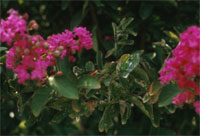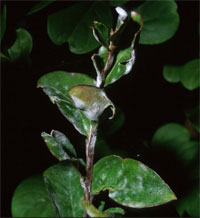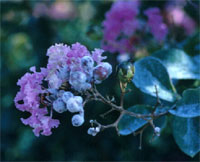Powdery Mildew on Crape Myrtles
Download PDF (PLPA-103)
 Crape myrtle is a woody ornamental with deep green foliage and bright colored bloom for summer pleasure. It also has interestingly textured trunks to accent the landscape in the winter months. Yet in the spring and fall months, some leaves appear to turn grayish white. This may be powdery mildew.
Crape myrtle is a woody ornamental with deep green foliage and bright colored bloom for summer pleasure. It also has interestingly textured trunks to accent the landscape in the winter months. Yet in the spring and fall months, some leaves appear to turn grayish white. This may be powdery mildew.
Powdery mildew (Erysiphe lagerstroemiae) is a fungus. This fungus grows in thin layers on the surface of leaves, shoots, buds and flowers. It can produce numerous spores, when seen under the microscope looks like chains of beads. These growth and spores give it the powdery-like appearance, hence the common disease name “Powdery Mildew”.
In the later part of the year, this fungus can produce an overwintering structure call the ascoma. The ascoma (also known as the clietothecia) is a small dark spherical structure about the size of a small poppy grain, and are easily observed amongst the whitish mildew. The ascoma survives the winter on leaves or plant debris, and will produce spores in the spring to that can reinfect the crape myrtles.
SYMPTOMS
Powdery mildew grows best on young, actively growing plant tissues. They may cover new growth entirely and cause severe damage to these parts. Older leaves are less likely to be affected, but can become infected under conducive conditions for the disease. This disease has a powder-like appearance on the infected surface. Infected shoots may dry up and shrivel. Severely affected buds will abort and drop off. Badly infected leaves may grow abnormally (curl and twist). Severely infection may also cause premature defoliation.
Powdery mildew spores are disseminated by wind. Under favorable conditions, infection may occur as few as 3 to 5 days after the spore lands on the crape myrtle. Powdery mildew spores can germinate and infect crape myrtle in the absence on free water on the plant tissue, as long as there is adequate humidity in the air. Warm days and cool nights (60° – 80°F) reportedly favor development and spread of powdery mildew. Powdery mildew growth may be arrested when leaf temperature is above 90°F.
MANAGEMENT
The best management method is prevention. Use resistant varieties, provide the plants with full sun, and using good cultural practices, such as avoiding excess fertilization and removing affected leaves in the fall, will adequately manage powdery mildew in most situations. Encourage good circulation through selective pruning and/or proper placement of plant in the landscape to reduce chances of spore settling and humidity level, and allows for full sun. Crape myrtles with good to excellent resistance to powdery mildew include Tonto, Muskogee, Acoma, Souix, Tuskegee and many other.
There are numerous fungicides, both natural and synthetic, that are available to control powdery mildew. Care should be observed when using any fungicide. Natural fungicides such as Neem oil extract and Potassium bicarbonate has been shown to be effective when used correctly. Fungicides are typically not needed at the hottest part of the year as the powdery mildew fungus is inactive and the fungicides may cause damage to the plants. For more information on natural and synthetic fungicides, please contact your local County Extension Agent.
Prepared by Dr. Kevin Ong
Assistant Professor and Extension Urban Plant Pathologist
Texas AgriLife Extension Service; The Texas A&M University System
December 16, 2004 (rev. 032508)
The information given herein is for educational purposes only. References to commercial products or trade names are made with the understanding that no discrimination is intended and no endorsement by Texas AgriLife Extension Service personnel is implied.
Educational programs of the Texas AgriLife Extension Service are open to all people without regard to race, color, sex, disability, religion, age, or national origin.
The Texas A&M University System, U.S. Department of Agriculture, and the County Commissioners Courts of Texas Cooperating

